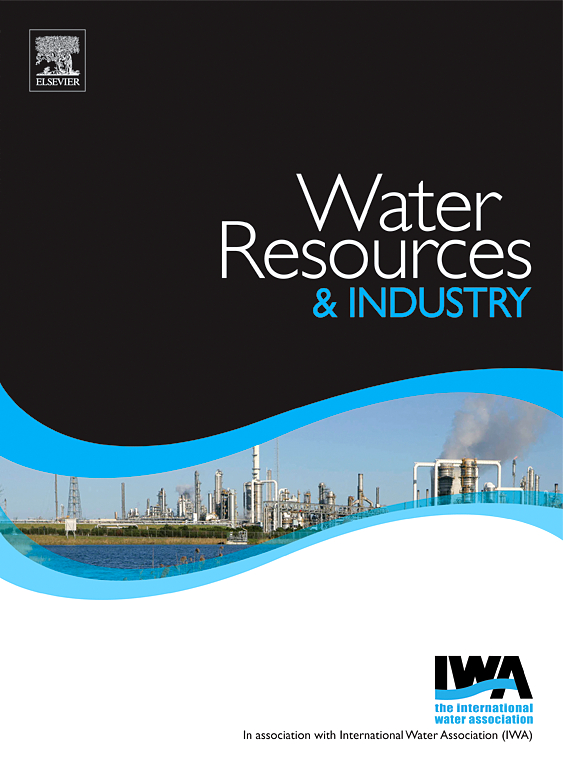污水泄漏的环境影响评估:以污水收集网络中水灰和碳足迹为例
IF 4.5
3区 工程技术
Q1 WATER RESOURCES
引用次数: 0
摘要
本研究考察了2023年2月至2024年1月在工业和城市环境中混合工业和城市污水(MWW)流动的动态。在研究期间,淡水总消耗量平均为85,228 m3/月,其中78% (66269 m3/月)转化为兆瓦。其中25%(16,758立方米/月)由于污水收集网络(WWCN)的泄漏而损失,而其余75%(49,511立方米/月)进入排放阶段。污染物分析表明,COD是所有采样点的主要污染物,MWW中的浓度为953.3 mg/L,而淡水中的浓度为1.8 mg/L,表明污染严重。灰水足迹(GWF)评价确定COD为关键污染物,产生MWW的峰值为1,260,468 m3/月,泄漏MWW的峰值为316,449 m3/月,其次是磷酸盐(PO4)的贡献。碳足迹(CF)评估估计WWCN能源消耗导致排放34,898 kg CO2/月(0.53 kg-CO2/m3 MWW)。由于未经处理的MWW绕过了处理过程,泄漏增加了污染负荷,浪费了能源,从而加剧了环境影响。这些发现强调了减少泄漏和优化MWW管理以最大限度地减少环境影响的紧迫性。有针对性的干预措施可以改善MWW基础设施的可持续性,提高资源效率。本文章由计算机程序翻译,如有差异,请以英文原文为准。
Assessing the environmental impact of wastewater leakage: A case study on grey water and carbon footprints in wastewater collection networks
This study examines the dynamics of mixed industrial and municipal wastewater (MWW) flows in industrial and municipal settings from February 2023 to January 2024. During the study period, total freshwater consumption averaged 85,228 m3/month, with 78 % (66,269 m3/month) converted into MWW. Of this volume, 25 % (16,758 m3/month) was lost due to leakage in the wastewater collection network (WWCN), while the remaining 75 % (49,511 m3/month) reached the discharge stage. The analysis of pollutants indicated that COD was the predominant pollutant across all sampling points, with concentrations of 953.3 mg/L in MWW compared to 1.8 mg/L in freshwater, demonstrating significant contamination. The grey water footprint (GWF) assessment identified COD as the critical pollutant, with peak values reaching 1,260,468 m3/month for generated MWW and 316,449 m3/month for leakage MWW, followed by phosphate (PO4) contributions. The carbon footprint (CF) assessment estimated that WWCN energy consumption led to emissions of 34,898 kg CO2/month (0.53 kg-CO2/m3 MWW). Leakage exacerbated environmental impacts by increasing pollution loads and wasting energy, as untreated MWW bypassed treatment processes. These findings highlight the urgency of mitigating leakage and optimizing MWW management to minimize environmental impacts. Targeted interventions can improve the sustainability of MWW infrastructure and enhance resource efficiency.
求助全文
通过发布文献求助,成功后即可免费获取论文全文。
去求助
来源期刊

Water Resources and Industry
Social Sciences-Geography, Planning and Development
CiteScore
8.10
自引率
5.90%
发文量
23
审稿时长
75 days
期刊介绍:
Water Resources and Industry moves research to innovation by focusing on the role industry plays in the exploitation, management and treatment of water resources. Different industries use radically different water resources in their production processes, while they produce, treat and dispose a wide variety of wastewater qualities. Depending on the geographical location of the facilities, the impact on the local resources will vary, pre-empting the applicability of one single approach. The aims and scope of the journal include: -Industrial water footprint assessment - an evaluation of tools and methodologies -What constitutes good corporate governance and policy and how to evaluate water-related risk -What constitutes good stakeholder collaboration and engagement -New technologies enabling companies to better manage water resources -Integration of water and energy and of water treatment and production processes in industry
 求助内容:
求助内容: 应助结果提醒方式:
应助结果提醒方式:


